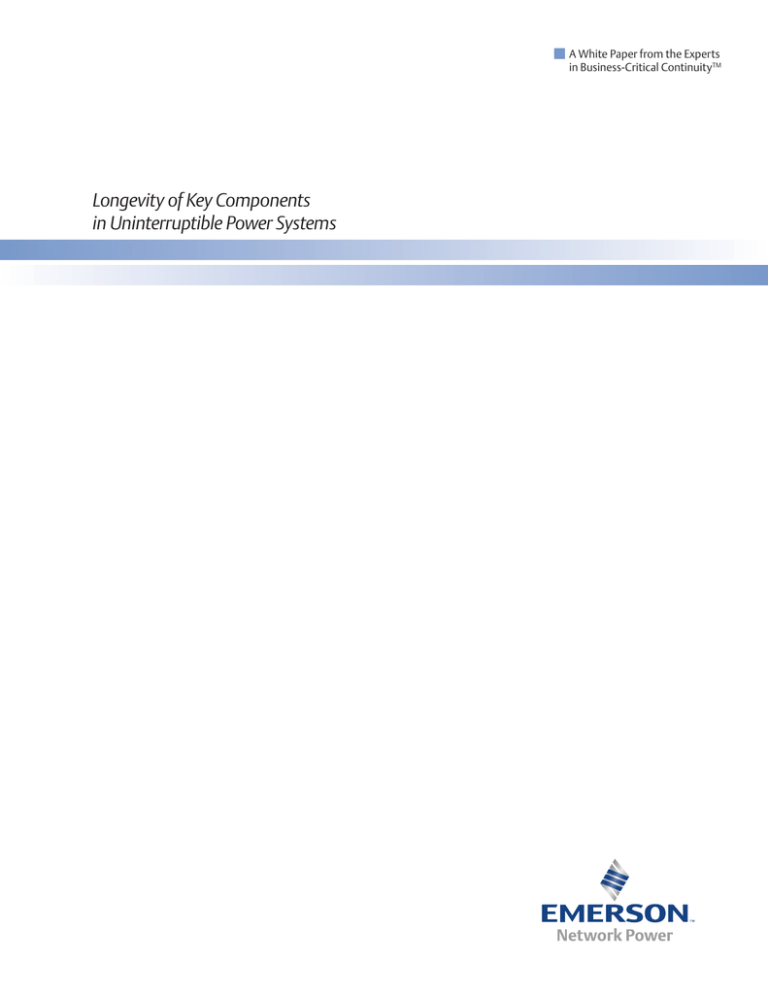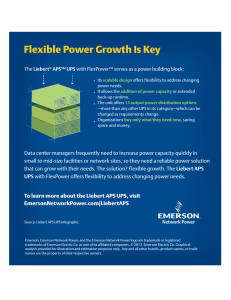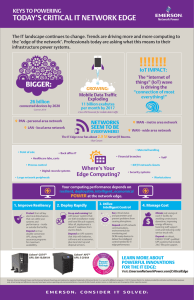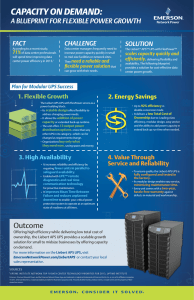
A White Paper from the Experts
in Business-Critical ContinuityTM
Longevity of Key Components
in Uninterruptible Power Systems
Executive Summary
Every UPS is designed with components that have a limited life. Some of these components
have longer lives than others and this depends on the design of the component itself, its
function within the UPS, and the operating conditions to which the UPS is subjected to.
In this white paper, we briefly discuss the functional life of key components and the frequency
at which Liebert suggests their replacement. Even though these key components have a
limited design life, a well planned preventive maintenance service on the UPS, that includes
the periodic replacement of these components, may ensure a continuous and reliable
operation of the UPS for many years to come.
1
Introduction
Power Semiconductors
A Liebert UPS has a design life well in excess
of 10 years. Well-maintained units can
continue to provide economic benefits for
20 years or more. Long-life components
are used in a UPS whenever it is practical
and cost-effective. However, due to current
component material and manufacturing
technology limitations, a few components
in a Liebert UPS will wear out and require
replacement in less than 10 years.
Power semiconductors do not have a rated
end of life in the normal mode of operation
of the UPS. SCR or IGBT failures are generally
secondary symptoms of other problems.
During the annual preventive maintenance
cycle, semiconductor devices should be
visually inspected for corrosion and for
damage to the hermetic seal. If corrosion
or seal damage is found, the device should
be replaced. In addition, gate leads should
be inspected and mounting torque of the
semiconductor hardware checked. We
do not recommend changing the power
semiconductors in a large UPS at
regular intervals.
In order to prevent a wear-out failure of one
of these components affecting the critical
load operations, it is recommended these
components be periodically inspected and
replaced before they reach their expected
wear-out life.
Electrolytic DC Capacitors
The reliability of any system only lasts as long
as the shortest component life in the unit.
The expected life of electrolytic
capacitors can be calculated as a function
of manufacturer’s rating and the expected
operating temperature of the device. Please
refer to Appendix A: Design Life Calculations
for Electrolytic Capacitors. The theoretical
service life of DC capacitors ranges from
8 years to 30 years, depending on system
bus voltage and UPS ambient temperature.
Magnetics: Transformers,
Inductors, DC Chokes
The design value of most magnetic
components is 40 years of operation. Key
factors here are the insulation used in the
winding process and the temperature rise
while in service. Our magnetics use Class
H insulation rated at 220°C, and are never
operated at higher than 150°C.
Experience proves that capacitors should
be replaced significantly before the end
of their rated service life. This helps account
for variations in ambient temperature,
air-borne contaminants and other
environmental factors.
Some commutation inductors (used in
SCR-based UPS modules) may exhibit
deterioration after ten to fifteen years
of service due to load variations and the
constant cycling of the current through the
inductor. Before it fails, the inductor starts
to vibrate and becomes very noisy. This
condition will be obvious during preventive
maintenance, and the Customer Engineer
can schedule a return visit to replace the
inductor. Experience has shown that with
proper preventive maintenance, no definitive
replacement interval is needed to preclude
inadvertent UPS shutdown.
Emerson Network Power recommends
replacing DC capacitors every six to
seven years.
Table 1 shows Theoretical Life at various
ambient temperatures. Refer to Appendix A
for the formula used to arrive at these figures.
2
Oil-Filled AC Capacitors
returns a second time for the same problem,
it is scrapped. All calibrations are verified
during annual PM to ensure that the circuit
boards don’t exhibit signs of failure. If
weakness is found during the PM, the
circuit board will be replaced.
The oil-filled capacitors have a design life
of ten years, and a replacement life of seven
years. As oil-filled capacitors approach their
design life, they are subject to the internal
breakdown of the soggy foils and possible
loss of capacitance. We recommend that all
oil-filled capacitors be inspected and those
within six months of their replacement life
(seven years) can be changed out during
the annual preventive maintenance (PM)
cycle. The oil-filled capacitors should also
be inspected during the annual PM for
deformation, which indicates that the
capacitor needs replacing. Changing the
AC oil-filled capacitors based on service life
is generally not part of most maintenance
contracts, but can be included.
The most serious limitation to circuit board
longevity is availability of replacement
components for some boards. Certain parts
are no longer available from manufacturers.
Emerson Network Power has safety stock
on some key components, but it’s difficult
to foresee all contingencies. Please note that
this parts-availability issue affects all vendors
of both static and rotary UPS products.
Limited Life Components
As mentioned previously, every UPS
is designed with components that have
a limited design life. A UPS’s functional life
is effected by its working conditions. The
typical limited life components found in
a UPS are listed on the following page in
Table 2, as well as the design life and
the time at which Liebert Services
recommends replacement.
Circuit Boards
There is no rated service life on the
components specified for use on the circuit
boards. Circuit boards with problems are
removed and returned to the manufacturing
plant for repair and test. Before they are
returned to service, they will have all
outstanding revisions incorporated and
will then be system tested. If a circuit board
DC Bus
Voltage
405
405
405
405
405
540
540
540
540
540
Ambient
Temp °C
20
25
30
35
40
20
25
30
35
40
Generally, power capacitors are considered
“failed” when the measured capacitance
is 5% below the nameplate rating. Typically,
storage batteries are “worn out” when its
full load reserve time is 20% below rated.
Site-specific battery plants may have different
end-of-life requirements. Fans and blowers
typically will stop rotating or rotate slower
than expected.
Theoretical Life
Hours
Years
279,351
31.9
197,531
22.5
139,675
15.9
98,765
11.3
69,838
8.0
293,318
33.5
207,407
23.7
146,659
16.7
103,703
11.8
73,329
8.4
In most cases, replacement components
must match exactly the original component
specifications. Many are not readily available
from 3rd party component distributors.
For assistance with your specific component
specifications, replacement component
selection and sourcing, call 1-800-Liebert
(1-800-543-2378).
Table 1
3
For customers using Liebert Services
Preventive Maintenance, periodic inspection
of these components are part of this service
as is a recommendation of replacement
intervals to avoid surprise interruptions in
critical load operations.
Conclusion
All UPSs are designed and manufactured
with components that have limited life.
The reliability and continuous operation
of a UPS can significantly be improved over
the years by properly maintaining it. This
preventive maintenance must include a
periodic system inspection and replacement
of key components that by design have
a limited life. Some of these components
may last longer than others, but the reliability
of the system can be compromised by
the component with the shortest design
life. Therefore, Liebert Services strongly
recommends that any UPS system be
periodically inspected and key components
be replaced to ensure optimum support
to the customer’s critical load.
Component
Power AC filter capacitors
Power DC filter capacitors
Low-profile fans
Squirrel-cage blowers
Air filters, disposable
Battery, lithium, logic memory backup
Battery, storage, lead-acid wet-cell
Expected Life
>7 years (~62,000 hrs)
>7 years (~62,000 hrs)
>7 years (~62,000 hrs)
>10 years (~87,600 hrs)
1 to 3 years
10 years
10 to 20 years
Battery, storage, valve-regulated
lead-acid
5 year battery
Replace In
5-6 yrs
5-6 yrs
5-6 yrs
8-9 yrs
Check 4 times/yr
8-9 yrs
1-2 yrs prior to
end-of-life
3-4 yrs
Battery, storage, valve-regulated
lead-acid
10 year battery
6-8 yrs
Table 2
4
Appendix A
Design Life Calculations for Electrolytic Capacitors.
The expected life of these capacitors has been confirmed to follow Arrhenius’
equation – a formula describing chemical reactions due to dielectric molecules
activated by thermal energy. We can calculate L, expected device life in hours,
according to the following:
L = LBASE x 2^((TBASE – TCORE)/10) x Voltage Multiplier
where:
LBASE
= 5,000 hours at 85°C core temperature and rated voltage
TBASE
= 85°C
TAMB
= 30°C
TCORE
= TAMB+ TRISE – AVG = 30°C + 10°C = 40°C
VR
= Rated Voltage
VA
= Actual Voltage
Voltage Multiplied = (2.50 – 1.5) VR/VA
= 700/540 = 1.2963 for 540 volts DC bus (480 VDC nominal)
= 500/405 = 1.23 for 405 volts DC bus (360 VDC nominal)
Solving this we get:
L
= 5,000 x 2^((85-40)/10) x 1.2963
= 5,000 x 2^4.5 x 1.2963
= 146,659 hours (16.7 years) for a 540 volts DC bus and 30°C
= 5,000 x 2^((85-40)/10) x 1.23
= 5,000 x 2^4.5 x 1.23
= 139,158 hours (15.9 years) for a 405 volts DC bus and 30°C
Substituting 40°C for UPS ambient temperature we obtain:
73,329 hours (8.4 years) at 540 VDC and 40°C
69,838 hours (8.0 years) at 405 VDC and 40°C
5
Emerson Network Power
1050 Dearborn Drive
P.O. Box 29186
Columbus, Ohio 43229
800.877.9222 (U.S. & Canada Only)
614.888.0246 (Outside U.S.)
Fax: 614.841.6022
EmersonNetworkPower.com
Liebert.com
While every precaution has been taken to ensure
accuracy and completeness in this literature, Liebert
Corporation assumes no responsibility, and disclaims
all liability for damages resulting from use of this
information or for any errors or omissions. Specifications
subject to change without notice. ©2008 Liebert
Corporation. All rights reserved throughout the world.
Trademarks or registered trademarks are property of
their respective owners. ®Liebert and the Liebert logo
are registered trademarks of the Liebert Corporation.
Business-Critical Continuity, Emerson Network Power and
the Emerson Network Power logo are trademarks and
service marks of Emerson Electric Co. ©2008 Emerson
Electric Co.
WP162-98
SL-24628
Emerson Network Power.
The global leader in enabling Business-Critical Continuity™.
AC Power
Connectivity
DC Power
Embedded Computing
Embedded Power
Monitoring
Outside Plant
Power Switching & Controls
Precision Cooling
EmersonNetworkPower.com
Racks & Integrated Cabinets
Services
Surge Protection




